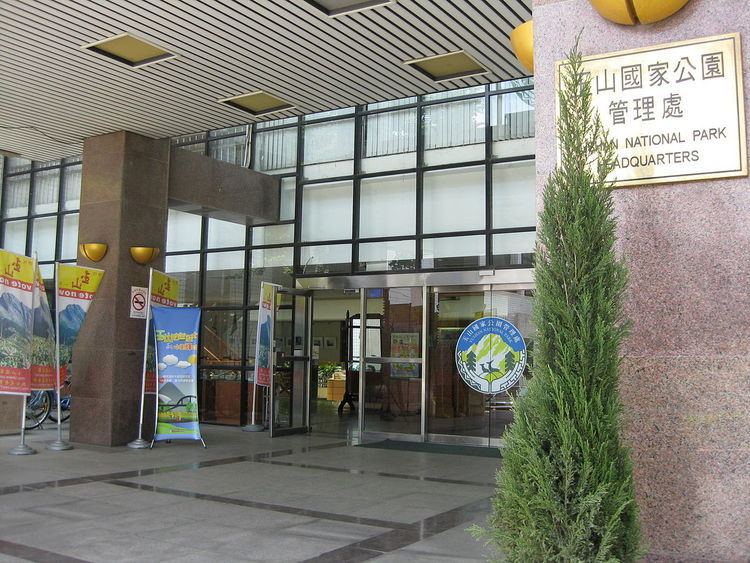Visitors 1,349,281 (in 2005) Phone +886 4 9277 3121 | Nearest city Dongpu Established April 10, 1985 | |
 | ||
Area 103,121 ha (398.15 sq mi) Similar Yushan, Shei‑Pa National Park, Taroko National Park, Lulin Observatory, Taijiang National Park Profiles | ||
Hiking on mt jade yushan national park taiwan gopro hero 4
Yushan National Park (Chinese: 玉山國家公園; pinyin: Yù Shān Gúojiā Gōngyuán) is one of the nine national parks in Taiwan and was named after the summit Yushan, the highest peak of the park. The park covers a total of 103,121 hectares including large sections of the Central Mountain Range. The park contains over thirty peaks more than 3,000 meters in elevation, and two-thirds of the area within the park is above 2,000 meters. The elevation difference in the park is 3,600 meters, and there are many canyons, cliffs, and valleys.
Contents
- Hiking on mt jade yushan national park taiwan gopro hero 4
- Eastern entrance of yushan national park hike yuli taiwan
- Geology
- Hydrology
- Flora
- Fauna
- Cultural heritage
- Eco tourism
- References
Because its remote location and entry control, Yushan National Park is not among the most visited national parks in Taiwan. Even so, the park still attracted 1,044,994 visitors in 2015.
Eastern entrance of yushan national park hike yuli taiwan
Geology
Taiwan, which owes its existence to the power of plate tectonics, remains a place of regular seismic activity. Examples of geological features such as fault lines, joints, and folding can be seen throughout Yushan National Park:
The southern Cross Island Highway and Yushan Scenic Highway both offer countless opportunities to witness the area’s special geological features.
Hydrology
Yushan area is an important watershed of main river systems in central, southern, and eastern Taiwan. It is the water sources of Zhuoshui River (濁水溪), Kaoping River (高屏溪), and Siouguluan River (秀姑巒溪). The Chenyoulan (陳有蘭溪), Jyunda (郡大溪), Nanzaisian (楠梓仙溪), Laonong (荖濃溪), and Lekuleku(拉庫拉庫溪) rivers are all young rivers from Yushan with V-shaped river bed. Jinmentong cliffs (金門峒斷崖) is a unique landmark along the Chenyoulan River (陳有蘭溪). It was formed when Chenyoulan River (陳有蘭溪) cuts through land traversed by a fault line, it showcases one of the best examples of headway erosion. Jinmentong cliffs (金門峒斷崖), Yunlong Waterfall (雲龍瀑布) and Yinyu Waterfall (乙女瀑布; also known as 七絲瀑布) are some popular scenic points in the park.
Alpine lakes such as Dashueiku (大水窟), Tafen Pond (塔芬池), Jiaming Lake (嘉明湖), and Tienchih (天池) are formed from rain and melting snows in the shadows of surrounding mountain peaks. These lakes provide animals including visitors precious water from the mountains. However, the ecosystem around them is fragile and need further protection.
Flora
Due to its unique geography and entrancing landscape, Yushan National Park is well known for its diverse climate zones and rich biodiversity. The plants found in the park spans from subtropical at its foothills to alpine at its summits.
A wide difference in altitudes, precipitous cliffs, and plunging valleys in the Yushan National Park lend to the park highly unstable weather conditions. Temperatures can vary from warm to cold at the same time at places relatively close. Therefore, the diversity of plants found here is truly remarkable. While accounting for merely 3% of Taiwan’s total land area, the park has fully half of Taiwan’s native plant species growing within its boundaries. In surveys, there are 2,522 different kinds of plants found in the park.
With increasing elevation, there are the following six vegetation zonations in the park:
Fauna
The park is home to a large variety of birds, mammals, reptiles, amphibians, and butterflies. Between the months of March and May, visitors have the chance to see processions of butterflies fluttering through mountain valleys. In the following table, it shows total different kinds of animals found in the park:
In the past, many of these species became endangered due to over-hunting; but with the establishment of the Yushan National Park, they are gradually making a comeback. Larger mammals such as the black bear, sambar deer, Taiwan macaque, and serows can sometimes be seen, and their call is often heard.
Cultural heritage
Prehistoric relics, such as stone tools and pottery, found in the Wangshiang (望鄉) and Dongpu (Tungpu;東埔) areas, provide evidence of early human occupation. The Bunun (布農), an aboriginal tribe, presently inhabits the villages of Dongpu (Tungpu;東埔) and Meishan (梅山). They emigrated from the coastal plains to the mountains some 300 years ago. Another tribal people, Tsou, who live in the west of the park, have been largely assimilated by the Bunun. Displacement of aboriginals by settlers occurred during the Qing Dynasty with the construction of the 100-km Patung-kuan Historical Trail (Batongguan Historic Trail; 八通關古道) in 1874 for defense purposes. Some stone steps, walls and guard-posts are the remains from that past.
Eco-tourism
To promote eco-tourism, the park has established protection laws and raised public awareness of the importance of nature conservation on one hand and provided public facilities for easy access on the other hand. Public facilities provided in the park include:
For public safety, a lot of bridges and wooden pathways have been installed on difficult terrain.
There are three visitor centers in the park:
